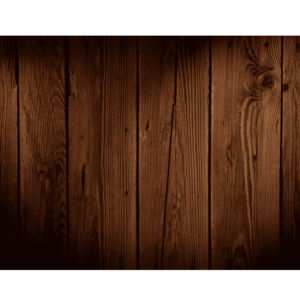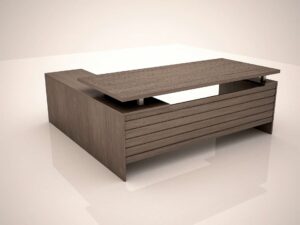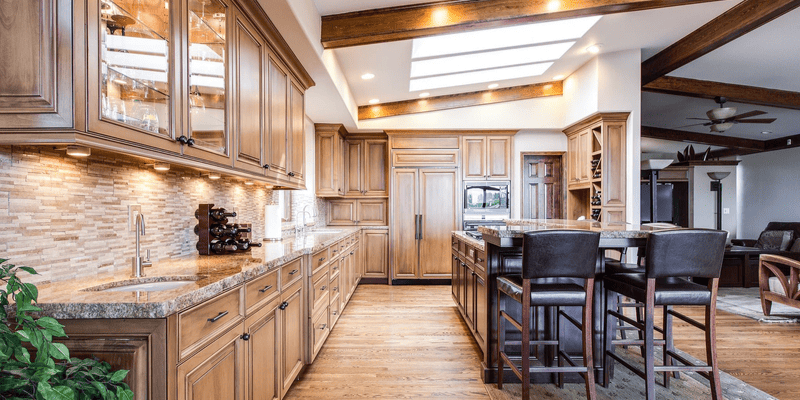Designing and renovating a home comes with its perks, it allows you to build your home with every detail and decision being yours – from flooring, cabinets, countertops, paint colors, etc. During the designing process there are multiple facets to consider when making decisions on what type of material you wish to be used throughout the home. The materials selected can play a major role in the environment and can potentially impact the overall air quality throughout the indoor space. When picking out materials, however, most people will lead with their aesthetic desires rather than focusing on the actual composition and hazards that certain building materials will create within the home when they begin to off-gas their chemical make-up into the airspace gradually.
The smallest of decisions can make a huge difference in a home such as the type of furniture you place in the home, the flooring you lay throughout the entire home, and even the type of cabinets and doors you have installed in the environment. Wood building materials, in particular, can be a type of material that may present certain air quality hazards and health risks to the home over time, creating a potentially unstable environment. Wood materials used in flooring, furniture, and cabinets may contain certain chemical treatments and finishes on their surfaces that can find their way into the environment through the chemical off-gassing process when integrated into the indoor space – which has the potential to wreak havoc on this personal indoor environment.
In this article we are going to discuss the impact of wood toxicity on indoor air quality and learn about the different chemicals that can be utilized and emitted from these wood materials used in a home.
What is Treated Wood
 When it comes to wood, there are many different types of woods that are used as building materials and each of these woods will utilize certain chemical compounds in their construction that can eventually taint the indoor environment. Pressure-treated wood is a type of wood that has been imbedded with chemical preservative that will work to protect the wood from rotting and insects that may tarnish the wood, prolonging the life of the material. Additionally, the chemical preservatives used on this wood will be the best way to prevent weathering and corrosions as well.
When it comes to wood, there are many different types of woods that are used as building materials and each of these woods will utilize certain chemical compounds in their construction that can eventually taint the indoor environment. Pressure-treated wood is a type of wood that has been imbedded with chemical preservative that will work to protect the wood from rotting and insects that may tarnish the wood, prolonging the life of the material. Additionally, the chemical preservatives used on this wood will be the best way to prevent weathering and corrosions as well.
When it comes to curing the wood and applying the chemical preservatives to the material, there are several different processes that can be used on the wood. One of the processes of treated wood being cured involves the wood being placed in a depressurized holding tank that removes the air and then replaces it with a preservative, this treatment uses high pressure to force a solution of water and preservative agents deep into the wood to extend its lifespan. After the pressure-treated wood absorbs the liquid solution of water and chemical preservatives during the curing and manufacturing process, the wood will usually arrive to the store still wet and the drying process can take several weeks to completely dry out from the material.
Is Treated Wood Toxic?
Does your home contain treated wood indoors that are responsible for chemical off-gassing smells and odors in the airspace? The treated wood contains preservative products that claim to control the degradation of the wood due to fungal rot or decay, sapstain, molds, or from wood-destroying insects. The use of these chemical treatments has the potential to result in pesticide exposure in the environment and in people. Additionally, wood can also be sealed using chemicals that can be toxic to the indoor environment and human health called polyurethane, which can emit airborne gaseous chemicals into the air known as Volatile Organic Compounds (VOCs).
Wood sealers, stains, and glues that are used on the wood treats the material and these types of chemicals used in pressed-wood can be used in furniture, kitchens, and even floorings in a home. When these other chemical applications are applied onto the wood materials it can introduce toxic chemicals into the airspace such as formaldehyde and other volatile organic compounds (VOCs). As these treated woods are placed into an indoor environment either in the form of furniture, flooring, or cabinets, it can begin the off-gassing process of these hazardous chemicals into the air as they acclimate to ambient temperatures which will lead to elevated levels of pollutants in the indoor air that can potentially adversely impact human health after exposure.
Wood Treatment Chemicals & Smells
The installation or placement of wood products in a home will lead to the development of elevated levels of chemical pollutants in the air in most cases, depending on the specific chemicals used on the wood material and how much material was placed into the environment. One of the biggest sources of wood treatment chemicals is the installation of wood floors throughout the entire home, which has the potential to release substantial levels of chemicals and chemical odors into the air. When it comes to the wood treatment chemicals and smells emitted from wood products found in a home, the chemicals used can range including chromated copper arsenic (CCA), polyurethane, formaldehyde, and other VOCs.
Below we are going to break down the different wood treatment chemicals and the wood smell that is releases into the environment and the different hazards produced from these chemicals that can contribute to wood toxicity.
 Chromated Copper Arsenic (CCA): Chromated copper arsenate (CCA) is a commonly used preservative that is used on treated wood to prevent rotting in lumber usually used outdoors. This chemical preservative contains arsenic, chromium, and copper within its construction that are integrated into the wood material. According to the National Center for Healthy Housing, CCA-treated wood can be dangerous to human health since the arsenic is a known carcinogen. Exposure to this chemical can potentially result in nerve damage, dizziness, and even numbness.
Chromated Copper Arsenic (CCA): Chromated copper arsenate (CCA) is a commonly used preservative that is used on treated wood to prevent rotting in lumber usually used outdoors. This chemical preservative contains arsenic, chromium, and copper within its construction that are integrated into the wood material. According to the National Center for Healthy Housing, CCA-treated wood can be dangerous to human health since the arsenic is a known carcinogen. Exposure to this chemical can potentially result in nerve damage, dizziness, and even numbness.- Polyurethane: Polyurethane is a plastic that is in the form of a liquid until it dries, and this can be used in both water and oil-based options. Polyurethane is a super-tough varnish that results in a finish that is much more resistant to water, solvents, abrasion, and to other varnishes. When an oil-based polyurethane is applied to wood products it will add a slight color tone and help to bring out the richness of the wood. This petrochemical resin contains isocyanates, a known respiratory toxin that can cause breathing problems like asthma and other health issues according to studies.
- Formaldehyde: Formaldehyde is a widely used chemical in building materials and household products. The presence of formaldehyde in a home is most significant in pressed wood products made using adhesives that contain urea-formaldehyde (UF) resins. Generally pressed woods in a home can be found in particleboard, hardwood plywood paneling, and medium density fiberboard used in wood products in the home. According to the Agency for Toxic Substances and Disease Registry (ATSDR), exposure to formaldehyde in the home can lead to irritation of the eyes, nose, throat, and skin, along with exacerbation of asthma and other conditions in those who suffer from them.
Is New Furniture Smell Dangerous?
 If you have recently laid new wood floors in your home, installed new wood cabinets, or even introduced new wood furniture into your home, you may be surprised by the strong chemical-odor that is emitted into the air from these wood products. As we discussed prior, furniture and the materials used to construct these items or pieces of furniture can contain a list of potentially toxic chemicals within its composition, particularly those items that contain wood as a major component. Wood can be heavily tainted by chemicals and preservatives that were introduced to the material during the manufacturing process either through treatments, sealants, or used as adhesives on the wood.
If you have recently laid new wood floors in your home, installed new wood cabinets, or even introduced new wood furniture into your home, you may be surprised by the strong chemical-odor that is emitted into the air from these wood products. As we discussed prior, furniture and the materials used to construct these items or pieces of furniture can contain a list of potentially toxic chemicals within its composition, particularly those items that contain wood as a major component. Wood can be heavily tainted by chemicals and preservatives that were introduced to the material during the manufacturing process either through treatments, sealants, or used as adhesives on the wood.
For those individuals who have experienced the distinct smell of a new car, the smell is a popular aroma that many people look forward to upon purchasing or leasing a new car. However, that new smell can be a hazardous concoction of chemicals that mix together to create this strong smell in the air. Similar to new car smell, new furniture can also form this same odor and in some cases, it can be far more aggravating to the human senses upon exposure. New furniture specifically can be exposed to and treated with certain harmful chemicals known as Volatile Organic Compounds (VOCs) that can be released into the air as a gas and emit a strong odorous aroma in the air of the enclosed space.
How to Speed Up Wood Furniture Off Gassing
When furniture and other household items are constructed with the use of chemicals and preservatives in their composition, it can result in the emission of these chemicals into the environment as the chemicals turn from a solid or liquid into a gaseous vapor in the air. The chemicals used in wood products and furniture like chemical VOCs such as formaldehyde, acetaldehyde, toluene, etc. will transition from a solid/liquid into a gaseous vapor during the process called off-gassing. Off-gassing is a chemical process that happens when volatile organic compounds (VOCs) that are found in the indoor environment begin to acclimate into the ambient indoor temperatures which will trigger the chemical to turn into a gas in the environment and spread through the air as a vapor that can be both odorous and toxic when in elevated concentrations in the indoor environment.
During the off-gassing process many indoor environments will experience a strong odor in the air that is the result of the gaseous chemicals in the air, and when this occurs you will want to try to speed this process up to minimize health effects from this chemical exposure. The best way to speed up the off gassing of wood furniture in your home is to increase ventilation and air flow and even elevate heat temperature within the environment. When an indoor environment has higher heat levels in the space, it can trigger the off-gassing process and allow for it to be expedited in some cases, if done correctly with the implementation of increased air flow and ventilation in the space. If you are experiencing off-gassing symptoms and conditions in your home from wood installation or additions in your home, you may need to implement this house hot boxing procedures to speed up the off gassing indoors.
How to Test Wood Flooring for Formaldehyde
 During the introduction of products into the home like wood products, it will contribute to levels of pollution in the air and in some cases the levels can spike to elevated levels that may be dangerous to both the indoor air quality and to the health of those that are exposed to the pollutants in their indoor environment. In particular, when large installations of material are placed in a home like wood flooring installation, the levels of VOCs like formaldehyde may be at concentrations that may require the assistance of air quality solutions to mitigate these chemical pollutants in the air. The best way to detect and test the levels of VOCs in your home’s air from wood flooring is by using an indoor air quality monitor or meter.
During the introduction of products into the home like wood products, it will contribute to levels of pollution in the air and in some cases the levels can spike to elevated levels that may be dangerous to both the indoor air quality and to the health of those that are exposed to the pollutants in their indoor environment. In particular, when large installations of material are placed in a home like wood flooring installation, the levels of VOCs like formaldehyde may be at concentrations that may require the assistance of air quality solutions to mitigate these chemical pollutants in the air. The best way to detect and test the levels of VOCs in your home’s air from wood flooring is by using an indoor air quality monitor or meter.
The Airthings Wave Mini is a smart indoor air quality meter that is perfect for your first step into understanding the health and comfort level in every room of your home. This air quality meter is small in size but big in impact, as it contains three sensors and low cost for total coverage. The Airthings Wave Mini is capable of measuring TVOCs, temperature, and humidity within the indoor environment, which is easily tracked using a smartphone app on your phone that provides detailed overviews of your air quality over time.
How to Get Smells Out of Wood Furniture & Flooring
As increasing levels of wood toxicity begin to occur in your home or other indoor environments, the process of getting the smells out of the wood furniture and flooring become necessary to alleviate and minimize air quality and health risks. There are many different methods that can be used to help get the smells out of wood, with traditional methods like using baking soda or vinegar on the source of the chemical odor to eradicate or minimize the odors. If you are dealing with a piece of wood that has a strong-chemical aroma, it may be necessary to use a chemical odor eliminator like the EnviroKlenz Everyday Odor Eliminator to completely eliminate the strong VOC chemical odors from the surface(s).
In addition, homeowners will try to increase ventilation and airflow in the environment to aid in the removal of the chemical smell of wood from the air, which can really help in the odor mitigation process. However, depending on the wood source that is exuding the chemical odor, the amount of chemical contained within this material, and the environmental conditions, the process of eliminating the chemical odors from the air may require a more powerful and effective solution such as the use of a VOC or formaldehyde air purifier.
Formaldehyde Air Purifier
Air purification is a significant aid to environments that are plagued with higher levels of pollutants such as allergens, odors, chemicals, and even chemical odors that can enter into a home and spread throughout the air of this environment. A home that has recently undergone construction, renovation, or cosmetic updates like new furniture additions etc. will be vulnerable to air contaminants from these activities and new introductions into the environment, thus it may leave the indoor air full of chemical contaminants that may be dangerous like volatile organic compounds (VOCs) such as formaldehyde. The implementation of wood products like new wood furniture, cabinets, or flooring can allow the entrance of these chemicals into the air which will leave the environment hazardous to those occupants of the home.
 The EnviroKlenz Air Purifier is your solution to remove VOCs from your home or other personal indoor environment, both safely and effectively. This air purification system addresses a broad spectrum of airborne pollutants including chemical odors, noxious odors, chemicals like VOCs, allergens, etc. The two-stage filtration system of the EnviroKlenz Air Purifier contains the (1st) stage is an EnviroKlenz Air Cartridge that contains the proprietary earth mineral technology of EnviroKlenz that is able to effectively capture, contain, and eliminate a broad spectrum of noxious and toxic odors from the air including VOCs like formaldehyde. The (2nd) stage filtration is a hospital-grade HEPA filter that is designed to capture and remove fine particulates from the indoor air, capturing them on a thick surface media – this filter can capture particulates larger than 0.3 microns at a 99.99 percent efficiency.
The EnviroKlenz Air Purifier is your solution to remove VOCs from your home or other personal indoor environment, both safely and effectively. This air purification system addresses a broad spectrum of airborne pollutants including chemical odors, noxious odors, chemicals like VOCs, allergens, etc. The two-stage filtration system of the EnviroKlenz Air Purifier contains the (1st) stage is an EnviroKlenz Air Cartridge that contains the proprietary earth mineral technology of EnviroKlenz that is able to effectively capture, contain, and eliminate a broad spectrum of noxious and toxic odors from the air including VOCs like formaldehyde. The (2nd) stage filtration is a hospital-grade HEPA filter that is designed to capture and remove fine particulates from the indoor air, capturing them on a thick surface media – this filter can capture particulates larger than 0.3 microns at a 99.99 percent efficiency.
Article Sources:
- BioResources: Understanding of Formaldehyde Emissions from Solid Wood: An Overview (link)
- National Center for Healthy Housing: Potential Chemicals Found in Building Materials (link)
- Agency for Toxic Substances and Disease Registry (ATSDR): Formaldehyde in Your Home: What You Need to Know (link)
Mobile Air System
✓ Patented earth mineral technology works to attack VOCs and break them down on a compound level
✓ No chemicals or masking agents
✓ Will not release any chemicals back into your environment
✓ Safer and faster at removing VOC’s than traditional carbon filters and PECO air purifiers








